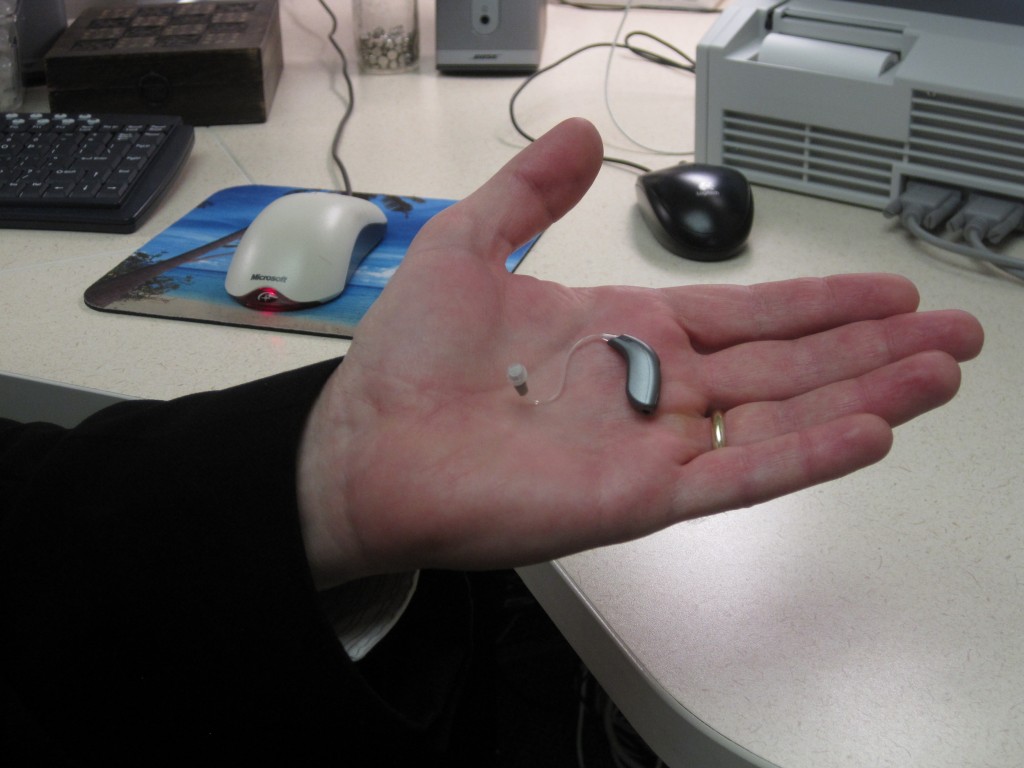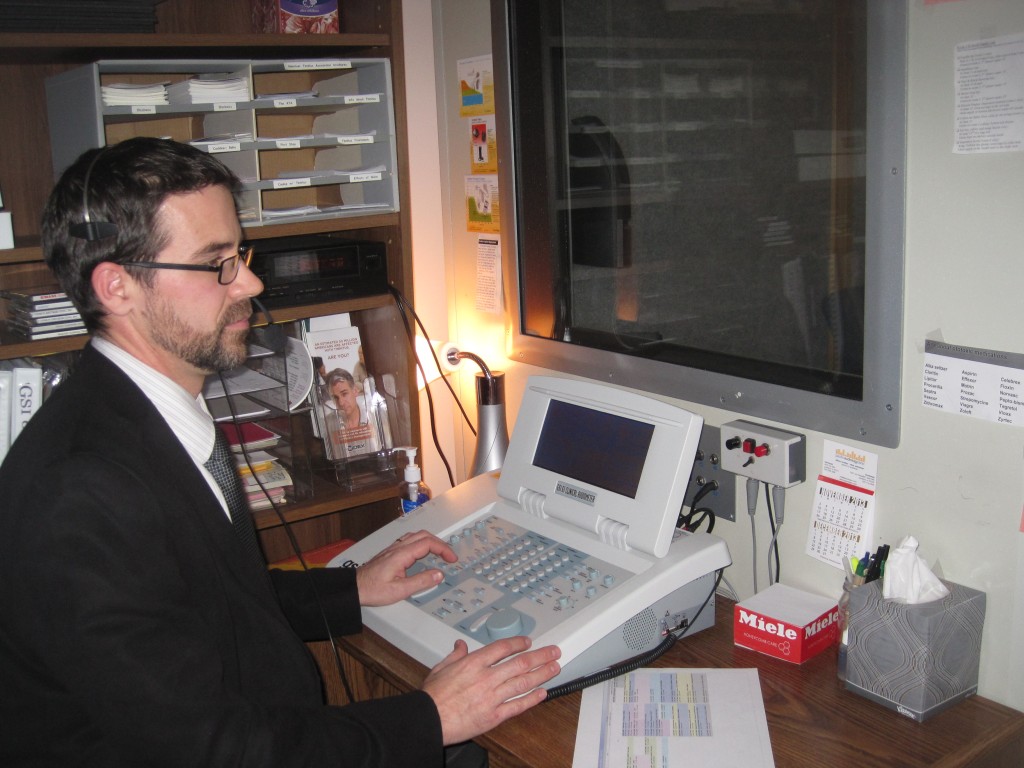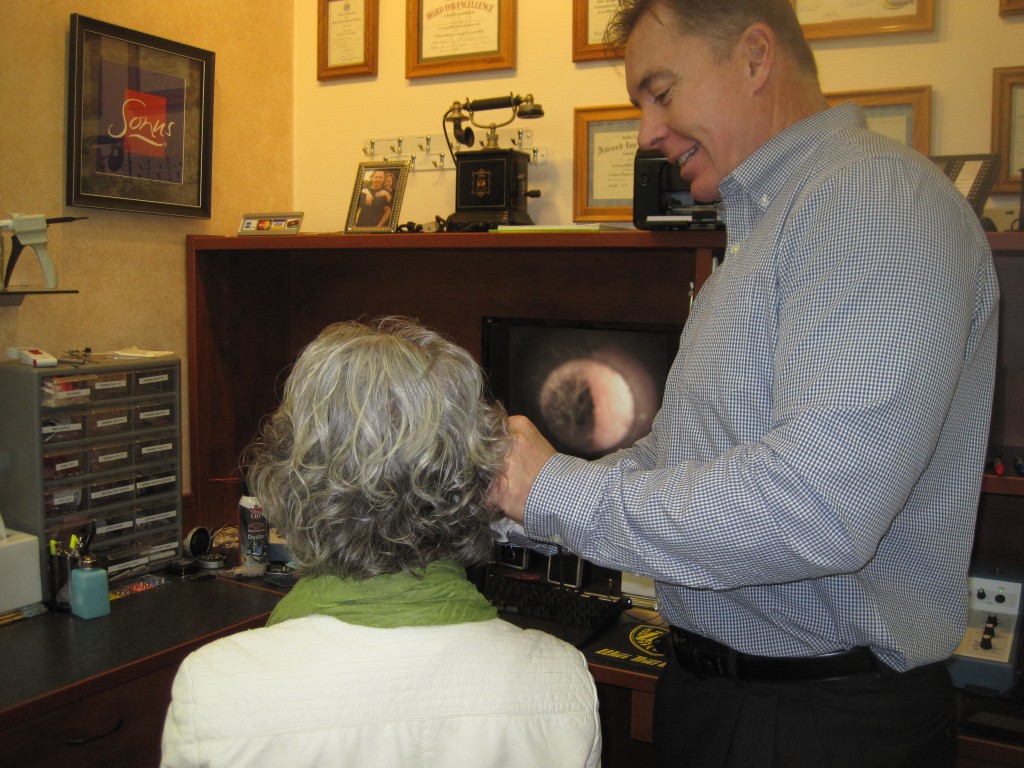Because I get to write about retirement issues for the Register-Guard and health issues for Boomer and Senior News, I feel like I’m mentally preparing myself for my old age. In writing this article, I learned that the ear is so sensitive that if you start to lose your hearing and don’t do anything about it or live in a quiet environment and don’t give your aural nerves anything to do, they will rebel by creating their own sound, leading to ringing in the ears and eventually permanent damage that hearing aids can’t fix. This was published in the February 2014 issue of Boomer and Senior News.

Dr. Brad Smith of Hearing Associates holds a small behind-the-ear hearing device. Photo by Vanessa Salvia
Say What?
Hearing loss is no fun, thankfully technology has improved
By Vanessa Salvia
Many people over the age of 40 probably have distinct memories of an older person in their lives who struggled with hearing loss. In decades past, people had to use large devices that frequently emitted high-pitched feedback. Having to turn down the volume on a squealing hearing aid was an uncomfortable fact of life for many people with hearing loss—these devices were in no way discreet. Thankfully, hearing aid technology has advanced significantly within the last 10 years.
“People always think about the hearing aides that they use to have to adjust the volume on while they were squealing,” says Dr. Brad Smith, a doctor of audiology with Hearing Associates in Eugene. “Those days are gone. We have very effective digital feedback suppression nowadays that can eliminate that feedback before the user or anyone even hears it.”
Most hearing aids have small electronic components, including a microphone that picks up sound, amplifier circuitry that makes the sound louder, a miniature loudspeaker (receiver) that delivers the amplified sound into the ear canal, and batteries that power the electronic parts. Most devices now are completely digital, meaning that they convert sound waves into digital signals and produce an exact duplication of sound. Computer chips in digital hearing aids analyze speech and other environmental sounds. These computer chips can be programmed, so that the sound they transmit can be matched to the specific needs of a person’s hearing loss.
Hearing is so fundamental to quality of life and communication, says Dr. Smith, but research shows that people generally wait 7 years before seeking help for their hearing loss. “That’s a long time to live with something like this,” says Dr. Smith. For some people, the final straw comes when they can’t hear a grandchild. Or perhaps it is causing discord with a spouse. Sometimes, there’s a lot of denial in wanting to get checked for hearing loss, says Dr. Smith. “People get dragged in here kicking and screaming sometimes. The person has to be ready and sometimes it takes a long time to get there. But,” he says, “it really does change someone’s life to treat a hearing loss. People can be helped, there are solutions.”
The human range of hearing as children is from 20 to 20,000 Hertz (a measure of frequency). As we age, we slowly lose high frequency hearing, which, unfortunately, is the range in which human speech is heard. So for most people, speech clarity is the first to go. “They may say that they can hear people talking, but they can’t understand it, it’s not clear,” explains Dr. Smith.
There are many things that can cause hearing loss. The ear is a complex organ consisting of the outer ear, middle ear and inner ear. The outer ear contains the eardrum, a membrane that converts and amplifies sound waves. The middle ear includes three tiny bones, the malleus (or hammer), incus (or anvil), and stapes (or stirrup). The middle ear also connects to the upper throat via the Eustachian tube. The inner ear contains the cochlea, that snail-shaped organ that receives sound in the form of vibrations, which cause the hair cells (stereocilia) to move. The stereocilia then convert these vibrations into nerve impulses, which are transmitted to the brain to be interpreted. “With normal aging the first loss is of the outer hair cells which are the amplifier of the ear, so if you lose outer hair cells you don’t hear soft sounds,” says Dr. Smith.
If that loss continues, then you also experience some changes to the nerve from lack of input. “It is a use-it-or-lose-it kind of thing,” explains Dr. Smith. “The nerve doesn’t get that input so the function is not preserved. That’s why it’s important to treat hearing loss. Over time, if that nerve is deprived then it doesn’t respond as well to treatment.” A lot of people with hearing loss have tinnitus, or ringing in the ears, as well, says Dr. Smith. “That’s a neural phenomena from not getting input to the nerve,” he explains. Treatment cannot reverse this, but it can be improved.
Grant Gording, of Grant’s Hearing Center in Eugene and Cottage Grove, offers their customers comprehensive hearing tests to determine what their level of hearing loss is. Gording says that they take time to get to know their customers to find out what’s behind the hearing loss—be it noise-induced, hereditary, medically induced, or all of the above. “We find out the situations they’re having difficulty in and also find out about their budget, they’re lifestyle, and how active they are to find the right type of device for them.”
For most people, age, genetics and noise exposure causes hearing loss, but there are a certain significant percentage of people that may have an underlying medical condition. Hearing Associates schedules an hour-long appointment for a first-time audiological evaluation. “We do a complete medical history, talk about day-to-day issues and have a battery of tests,” says Dr. Smith. “We review tests with the patient right them and make any necessary referrals. We take a lot of time to talk to the patients and make sure they understand their hearing status, the implications and what their options are.”
Grant’s Hearing Center offers devices that range in price and size, from $995 to $2450. But, Gording notes, each size has a full range of technology levels. “Hearing aides may look the same,” he says, “but they have different levels of technology, just as a computer may vary from other computers. For instance, some are slower, and some are fast and can multi-process.”
Hearing aids are very small and streamlined these days. They are known by acronyms such as BTE, behind-the-ear; ITE, in-the-ear; ITC, in-the-canal; and CIC, completely-in-canal. “The BTE, which is the thin wire with a miniature device behind the ear, is a huge part of the market now,” says Dr. Smith. “They’re so flexible. That sort of device leaves the ear canal open so sound enters naturally, and you program the device so that it is looking for those sounds that are a deficit.” At Grant’s, Gording says that with the ITC models, people express that they experience a “plugged up” type of sound. “But with the new technology and advancements we’re able to get past that.”
Dr. Smith says that there are good manufacturers and quality products out there that are very customizable. Still, the biggest predictor of someone’s outcome is the care they receive. “It’s the follow-up, the counseling, the maintenance, the level of care,” explains Dr. Smith. “This is very different from purchasing other electronic devices. They are medical devices and there’s absolutely a right way to do it.” Dr. Smith says a person is better off with a basic instrument that fits well than investing in high-end technology without an adequate fit.
Dr. Smith suggests shopping around to find a hearing specialist that meets your needs. There are different levels of training and certification, so ask questions. “Find someone that really has the know-how,” says Dr. Smith. “Ask, ‘What’s your experience? How long have you been doing this?’”
The ear bones are the three smallest bones in the human body. They may seem small enough to ignore, but they have a big impact on quality of life. Thankfully, this is one area where technology has kept pace with need, and there are many solutions out there.


No comments yet.